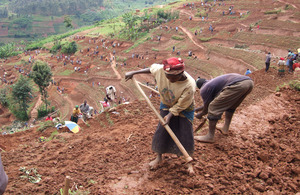DFID Research: Resource management and food security
A presentation delivered at the Food Security Futures Conference highlights the need for more resource assessment.

Building terraces in Rwanda to prevent soil erosion. Picture: Sam Thompson/DFID Rwanda
On the 11th to the 12th of April, Dublin hosted the Food Security Futures Conference as a precursor to the Ireland hosted EU Presidency Meeting, which incorporated the Hunger, Nutrition and Climate Justice event that took place this week (14th-15th April).
Leading researchers from CGIAR and the Food and Agriculture Organization of the United Nations gathered in Dublin to present papers on key topics that had long-term impacts on food security.
Looking at natural resource management (NRM), climate change and nutrition, participants considered how to meet the rising demand for food worldwide.
In a key presentation Frank Place of the World Agroforestry Centre (ICRAF) and Alexander Maybeck of FAO discussed the issues surrounding sustainable resource use.
They highlighted that between 2006 and 2050 agricultural production needs to increase by 60% and that the FAO estimates that as much of 80% of this will have to be met by yield increase.
This is due to the difficulties in cultivating new land, the main problem being the unequal distribution of usable areas. Many areas in countries with less agricultural land (or a need for more) are forested or rangeland and thus difficult to convert.
As well as new land, Place and Maybeck, pointed to the issues surrounding land degradation, highlighting that globally only half of all nutrients taken from the soil are replaced.
Turning away from problems of land allocation, the presentation looked at worldwide access to water, indicating that irrigation would be crucial in addressing food insecurity in the future.
Other sources of food were identified. Aquaculture and fisheries were looked at but, as with land usage and degradation, the most recent statistics pointed to the impacts of over fishing with over 29% of fish stocks depleted worldwide.
The overriding problem facing researchers was identified as the unequal distribution of land and water.
Nine systems were referred to as being at risk:
- Densely populated highlands in poor areas;
- Small holder rain fed farming in semi-arid tropics;
- Densely populated and intensely cultivated areas in the Mediterranean basin
- Intensive rained cropping in temperate climate;
- Irrigated rice-based systems;
- Crops depending on irrigation by groundwater;
- Rangelands on fragile soils;
- Deltas and coastal areas;
- Peri-urban agriculture.
However, the presentation did outline measures that could be taken to help negotiate a pathway through this seemingly bleak future.
Place and Maybeck highlighted the importance of integrated NRM practices; methods such as agroforestry which enable farmers to utilize forested areas to grow crops which benefit from the natural balance of soil nutrients. They emphasized the need to engage in knowledge sharing activities, allowing experiential knowledge to be communicated among practitioners on the ground.
These objectives were mirrored in the policy recommendations that called on actors to develop policies which support NRM, particularly at a local level. They also outlined the benefits of coordinating policies in order to share resources more effectively at regional levels.
By adopting a food chain approach incorporating all natural resources at a local as well as a national level, food demands could be met sustainably. However, to achieve this, Place and Maybeck highlighted the need for more research into resource assessment.
This presentation, and others, can be found on the website for the CGIAR programme on Policies, Institutions and Markets.
The Department for International Development provides core support to ICRAF through the CGIAR fund.